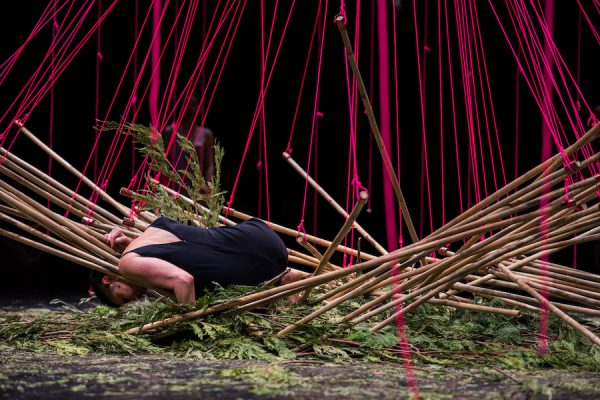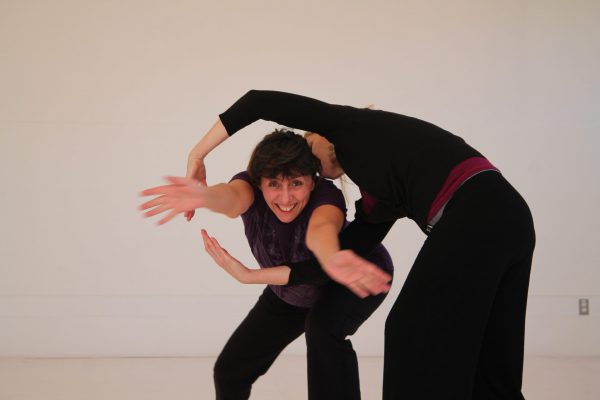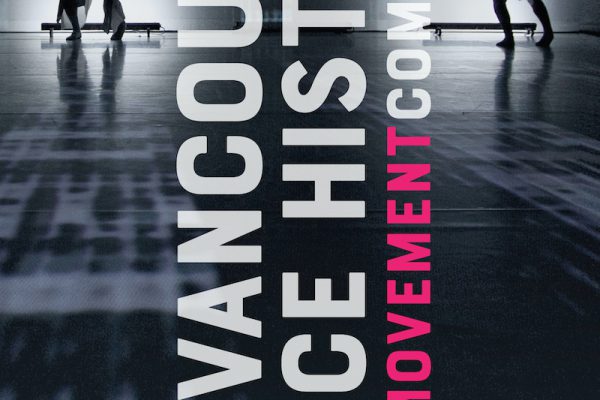It’s 1989 and Karen Jamieson is sitting in a dark theatre in Ottawa. She is there to take in a range of some of Canada’s best dance, on display as part of the new Canada Dance Festival. Jamieson’s own career is at its peak. Six years earlier she had created Sisyphus, named one of the ten Canadian choreographic masterworks of the twentieth century by Dance Collection Danse in 2003. But sitting there with the lights down, all she can think is “Is this it? Is this what I’ve given my life to?”
Years later Jamieson distinctly remembers that moment of feeling tired and bored. Especially bored. And not just bored by what was onstage, but by dance itself. Something was missing. “If you’re obsessively in love with one thing,” she tells me one afternoon outside her office on the top floor of The Dance Centre in Vancouver, “you have to almost fall out of love before you’re going to open up to other possibilities.”
Those other possibilities are why we’re meeting. She’s a Canadian pioneer in community-engaged dance and I’m curious as to how she came to make work in this way. How has making dance with non-professional community members extended from her own professional practice?
She tells me it all started after a commission from the National Art Gallery. It was during a site-specific dance next to an Emily Carr exhibit that required the involvement of the gallery guards. The piece was called Passage and because it was created in the space during the day and it moved throughout the gallery, the guards’ guiding role became part of the piece — advising the audience to optimal places to watch, how not to be in the way and any other bits of inside knowledge they took pleasure in imparting. Speaking about the process, Jamieson reflects on it as a reconsideration of how different dance could look and who else it might include: “That was a key moment that opened me up to how this art form could extend.”
After this experience, Jamieson decided to slow down the incessant demands of a professional career and invest in a seven-year collaboration with the Gitk’san Dag’m Haast Dance Group in Vancouver under the tutelage of Chief Kenneth Harris. Her degree in philosophy and anthropology came in handy as professional dancers and First Nations traditional dancers worked together to create choreography. Jamieson was collaboratively discovering a new approach to making dance by creating with community.
It was “dancing that reflected the stories and history of community,” she says, “where people dance as children until they’re old people. It was utterly different from professional dance as I had known it and practised it.”
This experience gradually grew into what is now identified as community-engaged dance — dance created with non-professional community members. It’s more of an approach or practice than a form, and in the last three decades it has been growing in Canada. For many observers, the last decade has been the real boom, especially in Vancouver where the practice is quite prominent and integrated with the professional community — their values overlapping.
In the fall of 2016, I had the opportunity to investigate community-engaged dance in Vancouver. I spoke with leaders and participants, community organizers and facilitators and got to move around myself. I’d been having my own “What is dance to me?” moment and found this exploration into community-engaged dance and its current practice beautifully enlightening. Here’s what I’ve learned about community-engaged dance in Canada.
~
Community-engaged dance doesn’t look like any dance you can list — ballet, hip hop, square dancing — but it uses similar qualities and borrows movements from every kind of dance because it springs fluidly from each participant’s imagination and creative desires. Community-engaged dance is collaborative choreography made from improvisation or through improvised scenes.
“Take this idea of lightness,” says the leader of one workshop I dropped into, “and let it move from the tips of your toes up and out the top of your head.” As the music comes on, nervous smiles are exchanged before the focus drops into the body and the movement begins. Feet lift, knees bend, arms extend to the sides — everyone’s finding what lightness means to them. Most eyes remain fixed on the floor, or sort of glazed in self-concentration, but after the idea seems to have run its course, most eyes look around, checking for group consensus that this one dance is done. The next idea is offered and a new improvised dance begins.
Because there’s no codified technique, each facilitating artist decides how best to lead her or his (though mostly her) workshops based on their own dance practice and who is in the room. The term “workshop” is used instead of “class” to negotiate expectations. Steps might be learned, but it’s not about learning how to dance; it’s about learning about the craft of dance — how to make art. Workshops are often cumulative, meeting weekly and usually leading up to a public performance. Not everyone is interested in performing, and that’s fine, but performance can be an important part of the process.
“It’s important for people to be seen,” says Jamieson, who has been leading community-engaged dance workshops in Vancouver’s Downtown Eastside for over ten years. “Dance is a communicative art and there’s something magical about creating something and sharing it as opposed to just going to workshop after workshop. Creating with people is very heterarchical.”
This idea of a choreographic system that is non-hierarchical is a main principle of community-engaged dance and one that is not typically seen in any other kind of performance dance, where a choreographer’s vision is often the last word. Artists working in community-engaged dance are said to be “leading from beside,” allowing participants to create and piece together their own movement, which is what makes this kind of dance empowering and inherently inclusive — it’s dance for everyone.
Location influences the makeup of different community groups, though in Vancouver many individuals travel between community centres and projects so that they can increase their dancing throughout the week. The location of Jamieson’s Carnegie Dance Troupe in Vancouver’s Downtown Eastside means the participants often come from all over the map, each with distinct histories and usually hardships, before removing their shoes and joining the group in the workshop’s opening meditation circle.
Heather Blais was homeless when she first joined the Carnegie Dance Troupe four years ago. In her fifties with two adult children, Blais was invited to join by a fellow group member at the Pender Community Health Centre. She says she was nervous to attend because she knew nothing about dance, but now the group and community dance have become her social network, a place where people notice if she’s not there and welcome her back when she returns. Blais sculpts the space with her arms as she tells me, “The dance here is about concepts, not steps. It’s about your own experience.”
For Swallow Zhou, a sixty-four-year-old woman from China, it has also been community making. Zhou moved to the neighbourhood by herself several years ago and takes time off work to make it to dance twice a week. She says friends back home criticize her for choosing dancing over a full week’s pay, but for Zhou, it brings her joy and she believes life is for learning and that she learns a lot from dancing. Sitting beside me during a workshop break, Zhou volunteers: “It’s very human to dance. In this community, we don’t have a lot of money but we can be happy.”
The group premiered their work called Metamorphose in October 2016 after collectively working on the piece for three years. At the performance, I sat beside a creative writer who just happened upon the event. Afterwards, I asked her what she thought of it and she said it was nice, powerful, but mostly she was speechless. As a dance writer, I get it: it can be hard to find words for what the body has just said so succinctly.
The dancers enter the space in a line from the corner, slowly plunging imaginary paddles to their sides with each purposeful step. Step, plunge, twist — the effort as real as if they were actually surrounded by water. Once a circle is formed, they hold hands and come together for a brief meditation. Stepping back to give the circle more space, the performers move through patterns of breathing guided by the hands — gathering air up on an inhale and flipping the palms to push the breath down on the exhale. From a sense of groundedness, the group shifts their weight forward and starts experiencing a tipping point — rising just barely off the floor to the balls of their feet and back down again. Sixteen beating hearts begin to move as one.
The practice first became more mainstream in the United Kingdom, where I first came across it in 2008 while studying abroad in Chichester. I wouldn’t have been able to identify it then, but the collaborations with community there were much more integrated than what I later experienced as a dance professional in Toronto. Professional dance artists were working more closely with community and not just for outreach and education. In contrast, the artists I was familiar with in Toronto seemed to include community more as an extension of their marketing work while on tour, or with the aim of animating a community for a short period of time, which is not what I’ve come to understand as community-engaged dance.
Prior to knowing what this specific approach was, I questioned the sincerity of community dance projects that sounded as though they had been designed around a grant application checklist, which has often been the case in vulnerable, marginalized and high-risk communities. Was working with community a fabricated mandate added to appeal to funders? Were these artists really invested and even qualified to be working with the communities that they claimed to be “animating?”
Douglas Durand, a cultural planner with the City of Vancouver, has been witnessing this shift since his return to Canada after a contract in the United Kingdom in 2000. Prior to this contract, Durand had almost three decades of work experience with professional dance in Canada. In the 1970s he lived in Montréal and was involved with Le Groupe de la Place Royale (later known as Le Groupe Dance Lab), an incubator of dance creativity in Canada. He also worked for Canada’s Royal Winnipeg Ballet and in Toronto with Dancemakers, another incubator for creativity in Canada. By the time Durand moved to London, community-engaged dance still wasn’t really on the radar in Canada.
In London, however, Durand found that “There was already a history, an infrastructure and an acknowledgement of the value [of community engagement].” Big names in dance like Wayne McGregor, now resident choreographer at The Royal Ballet, valued working with community, partly because of the access to large groups of people but also because of the movement coming from these individuals. “They weren’t bringing all of that training and dance experience,” says Durand. “They were bringing life experience to the stage.
In contrast, the professional communities in Canada were often hesitant to accept practice that included amateurs. “At first no one believed in it,” says Kaija Pepper, editor of Dance International out of Vancouver. “I remember distinctly everybody, and probably myself included, being quite distrustful of what [Jamieson] was doing.”
Pepper remembers walking through the streets of the Downtown Eastside over fifteen years ago with Jamieson and her “ragtag band of dancers” as part of a festival. “It was kind of strange; here we were, walking through the poorest street in the country but you know, there was joy there. People had made something that they wanted to share.”
From an aesthetic perspective, community-engaged dance is not comparable to professional dance, nor does it try to be, but it might be more relevant as art today than some narrative ballets or even some abstract contemporary dance. As Jamieson describes it, “An art form that is not current with what’s actually going on with society, in this political landscape, can only become irrelevant. I mean look around you. Walk down the street. Look what’s going on at every level of political and social change right now. It’s asking for dialogue. It requires dialogue.”
Last fall, Vancouver hosted Canada’s first symposium on community-engaged dance. Practitioners from the United Kingdom, the United States and across Canada came to take part in the series of panels and workshops.
Marie Lopes, an arts, culture and environment programmer at the Roundhouse Community Arts and Recreation Centre, says in the last few years there’s been an “explosion” of community-engaged dance projects in the city. “More and more people are interested in the co-creative processes of dance,” she says. “There’s been a notable growth of artists doing this kind of work in our city.”
Lopes and a colleague recently published a research paper exploring the productive intersections between leisure, recreation and community-engaged arts practice, with a special focus on dance. Though she says these things usually come from a few directions at once, as in no one person is responsible for the phenomenon, she mentions that Jamieson was the first dance artist to propose a community-engaged dance project in 2001 to the Roundhouse and to the Vancouver Parks Board.
Community-engaged dance has been fostered since its early days in Vancouver at the Roundhouse, the old western terminus of the Canadian Pacific Railway. After its renovations and brief use for the World Exposition of 1986, the centre became uniquely dedicated to community development through arts and culture. By 1997, when the Roundhouse officially opened its doors, the Vancouver Park Board had made a concerted effort to host community-based dance projects. “The Park Board runs artist residency programs throughout the city and they all have a community-engaged focus,” says Lopes.
As of last year, the City of Vancouver supports thirteen dance projects, ranging from The Moberly Multicultural Senior Dancers to the All Bodies Dance Project, a group that integrates dancers with or without disabilities.
Surrounded by the darkness of the Roundhouse’s black box theatre, two dancers sit perched on top of a table centre stage. They both look casually out at the audience, legs dangling toward the floor. This duet features All Bodies Dance Project co-founder Naomi Brand with writer, director and performer Adam Grant Warren. Warren was born with cerebral palsy and usually uses a chair for locomotin, but in this dance he’s using his arms and the strength of his torso to hop on and off, slide over and under the central prop with ease. What we see is not two differing abled bodies but the flowing dynamics of a relationship over time — one up when the other down, one as a counterweight to facilitate the other’s daring moves or doing the opposite and just letting go. And in stillness, two beautifully complex bodies in a conversation that requires no words.
Community-engaged dance is concerned with removing barriers — it’s about dance for everybody and for every body, no matter age, gender, sexuality, race, disability, education or economic circumstances. Inherent to its value system is an open door policy, where individuals can drop in at any time. Projects are often works-in-progress over many months or years but the open door concept remains the same, an important differentiation from other recreational activities at community centres. Workshops are also often free.
After attending two workshops with Jamieson and her Carnegie Dance Troupe, I was curious about how artists from a younger generation are running community-engaged dance in the city. I reached out to Desirée Dunbar, a dancer, choreographer and educator in her forties, to learn about her approach and ideologies.
In her workshop, Dunbar is laid back but pays keen attention to everybody in the room, most of whom are senior adults. Dunbar has been working in community-engaged dance since 2000 and enjoys bringing her love of making dance to groups of amateurs. “For me, it’s [about] how can I cultivate the embodiment of creativity and then let that positively ripple through the rest of [the participant’s] lives.”
Dunbar describes one participant, a retired teacher who, after working with her, took up painting and jazz singing. He said he discovered this whole creative side he never knew existed. “Kids go to the playground,” she says. “They don’t think about it later, necessarily. We’re just here to have fun. It’s permission to have fun.”
But what Dunbar is doing is more than just letting adults take playtime back. She’s creating an environment where individuals can express themselves and even rediscover happiness. I participated one afternoon and found that these workshops move participants from overthinking movement choices to just being present in their bodies. There’s so much information to process in the act of dancing that it’s a relief to just settle into the silliness and seriousness of the present — to not plan too much in advance.
Though community-engaged dance is not therapy based, the healing quality of expression is what attracts many participants. “It’s changed my life,” says Denise Linnay, a short, grey-haired, sixty-nine-year-old woman from Ottawa, a regular in Dunbar’s Monday afternoon workshops. “When I’m stressed I disassociate, but here I’m reconnecting to my body.”
For Linnay, the embodiment and connection to others in the workshop has been what no therapy could provide. You need both, she says, as a survivor of abuse. When Linnay first started attending workshops last year, she was living in a shelter. She now has her own place and is considering going back to school.
Dance as healing and for reconciliation is at the core of community-engaged dance, however loosely. “There’s research out there that says if you really want to heal trauma, you have to go through the body,” says Hailey McCloskey, a local dance artist and community-engaged dance workshop leader currently mentored by Jamieson. “Most of us have experienced some trauma, so everybody has healing work to do.”
Another young workshop leader in the city is Mirae Rosner who says the healing aspect of dance was apparent to her when working in community-engaged dance, but she signed up to the Express Arts Therapy program at Langara College to learn more.
“I wanted to better understand the connections between art and health,” says Rosner, who also works with Jamieson and makes connection between what she’s learned and the work Jamieson developed on her own. Jamieson’s “approach is based in her own deep personal connections to physical practice. She is working with principles that she has found work as a way for her to connect to participants and pave the way for her choreographic vision.” Some of those principles, Rosner learned, align with principles used when working with trauma.
But don’t think community-engaged dance is a form of therapy. When I mention this to Jamieson, she is quick to clarify any suggestion that what she is doing is therapy. “This isn’t dance therapy,” she says. “This is dance. It’s dance as art, and I think art transforms and art heals.” The way dance heals, says just about everyone I spoke to, is by leading with movement. Professional artists don’t direct from the front of the room, they are in the middle dancing as well. And when they do speak, they’re thoughtful and soft-spoken.
“Feel it in your body when you pull back, as though you were trying to rein a horse in,” says Jamieson one afternoon.
“Use just as much energy as you need to complete the action … Simply walk.”
“Be still … All dance comes out of stillness.”
For her part, Jamieson has spent close to twenty years finding the right language to use in workshops. She says it’s so that the experience “takes people where I want to take them and doesn’t clog them up with a lot of words — to shift them out of the verbal brain and into the dancing brain.”
Starting from movement puts the individual into an experience and sensation first. And sometimes, I’ve found, it’s just a relief not to have to talk. Many of our lives are so overwhelmed with text and dialogue that it can be a gift to experience the opposite. One of the days I dropped into the Carnegie workshop, I was looking forward to entering the space knowing that talking wasn’t a big part of what I was about to be doing. And unlike meditation, or other practices people seek for stress reduction like yoga, community-engaged dance is about being with people and sharing. You just don’t have to talk about it.
Being in the workshops also reminded me of how much we learn about each other without exchanging words, by just watching how others move. I see how dancing with others, communicating through movement, has the potential to build community.
Just imagine, if community-engaged dance were to continue to grow in Vancouver and across the country, it could have the potential to be a powerful tool for diversity, inclusion, reconciliation and healing — for those watching and doing. It’s a listening we don’t do enough of but one we’re desperately in need of. If you’ve ever asked, “Why dance?” this work is a subtle yet forceful answer.
Tagged: Community Practice, Contemporary, BC , Vancouver




